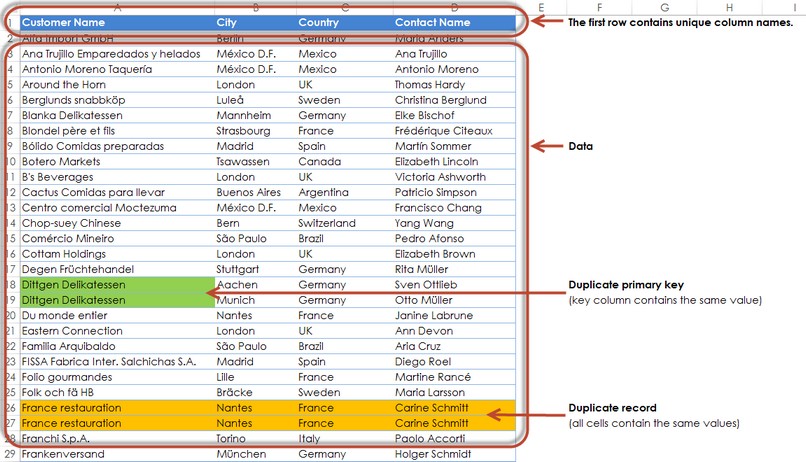|
<< Click to Display Table of Contents >> General Information About Databases |
  
|
|
<< Click to Display Table of Contents >> General Information About Databases |
  
|
Prior to describing the types of differences, we want to give a brief comparison of "normal" worksheets versus databases.
do not contain column headings and no database structure. For such worksheets, Synkronizer performs a cell-by-cell comparison. As a frequent user of Synkronizer you will soon learn that the data comparison of a "normal" worksheets is not as efficient as a database comparison.
are worksheets that contain data within a database structure. The data must be arranged as follows:
| • | The first row contains unique column names. |
| • | The database contains one (or more) column(s) with primary key(s) (unique identification number, article number etc.). A primary key uniquely identifies each data record and facilitates the sorting and synchronizing of your data. The primary key does not need to be a single field (e.g. employee ID). It may consist of multiple fields (e.g. family name, first name and city) to create a unique identifier and avoid duplicate keys/records. |
| • | The data must be sortable and can not contain any merged cells. |
| • | The table can't contain formulas that refer to other rows. Formula references to other columns within the same row are allowed. |
Following paragraphs describe the difference between a 'duplicate key' and 'duplicate records'.
Duplicate keys occur, when data records contain the same primary key. Assuming the primary key is formed from the family and first name, and given you have several customers called "John Miller" in your database, Synkronizer will not know which data records to compare. So make sure you operate with unique primary keys when working with Synkronizer.
Synkronizer also checks whether your database contains duplicate records (or redundant records). These are records where all fields (not just the key fields) are equal. If Synkronizer finds any of these records, they will be highlighted in gray. Duplicate records do not serve any purpose and should be deleted.
The comparison of "databases" is highly efficient. The databases may be sorted or altered. Inserting and deleting of columns and rows is allowed. Synkronizer will recognize all differences between the two files.
